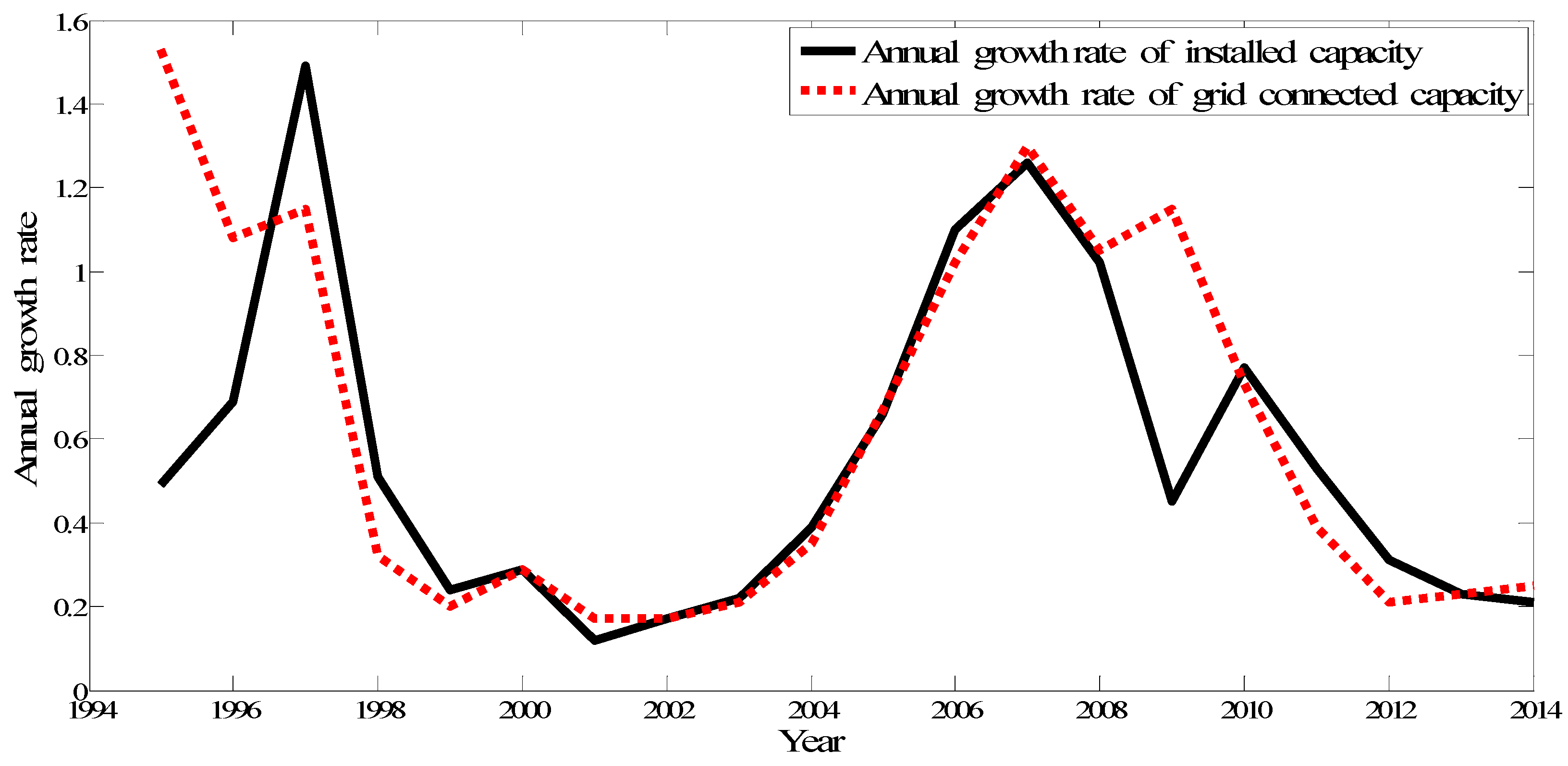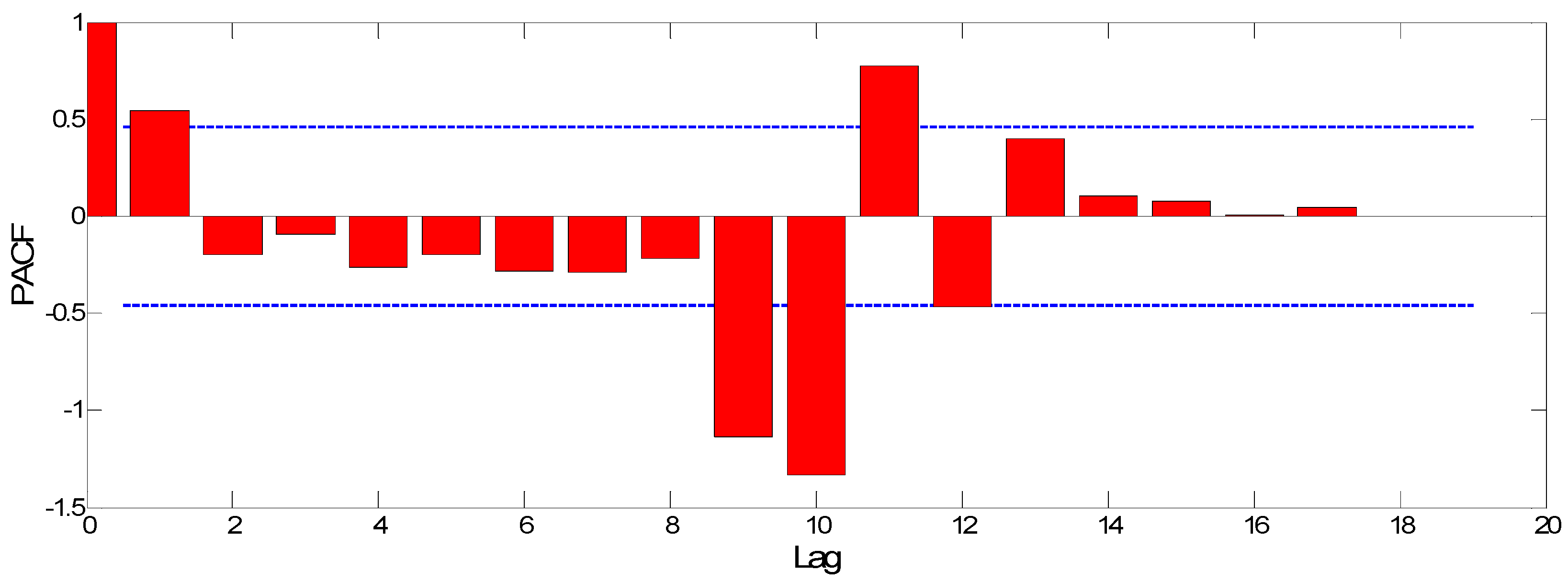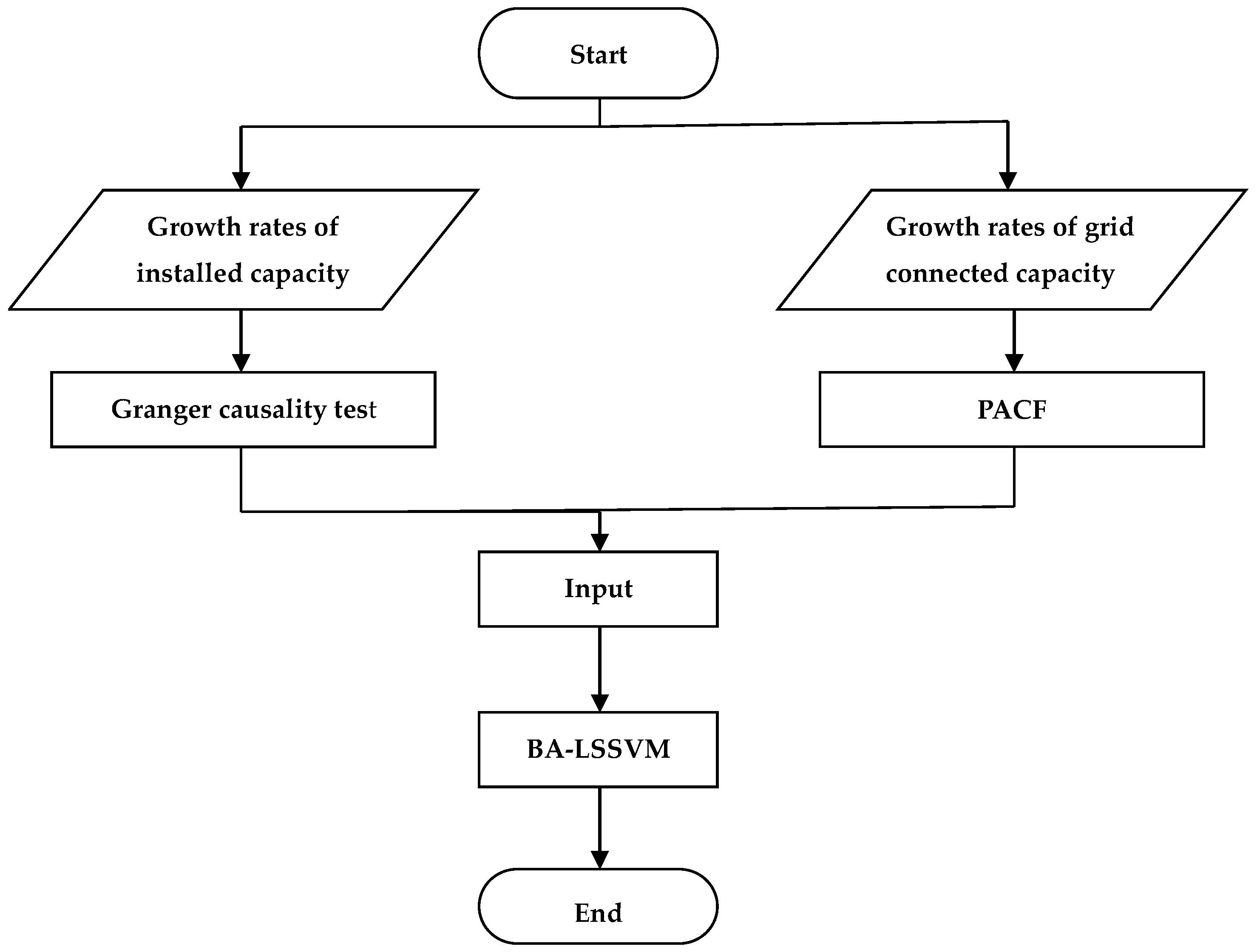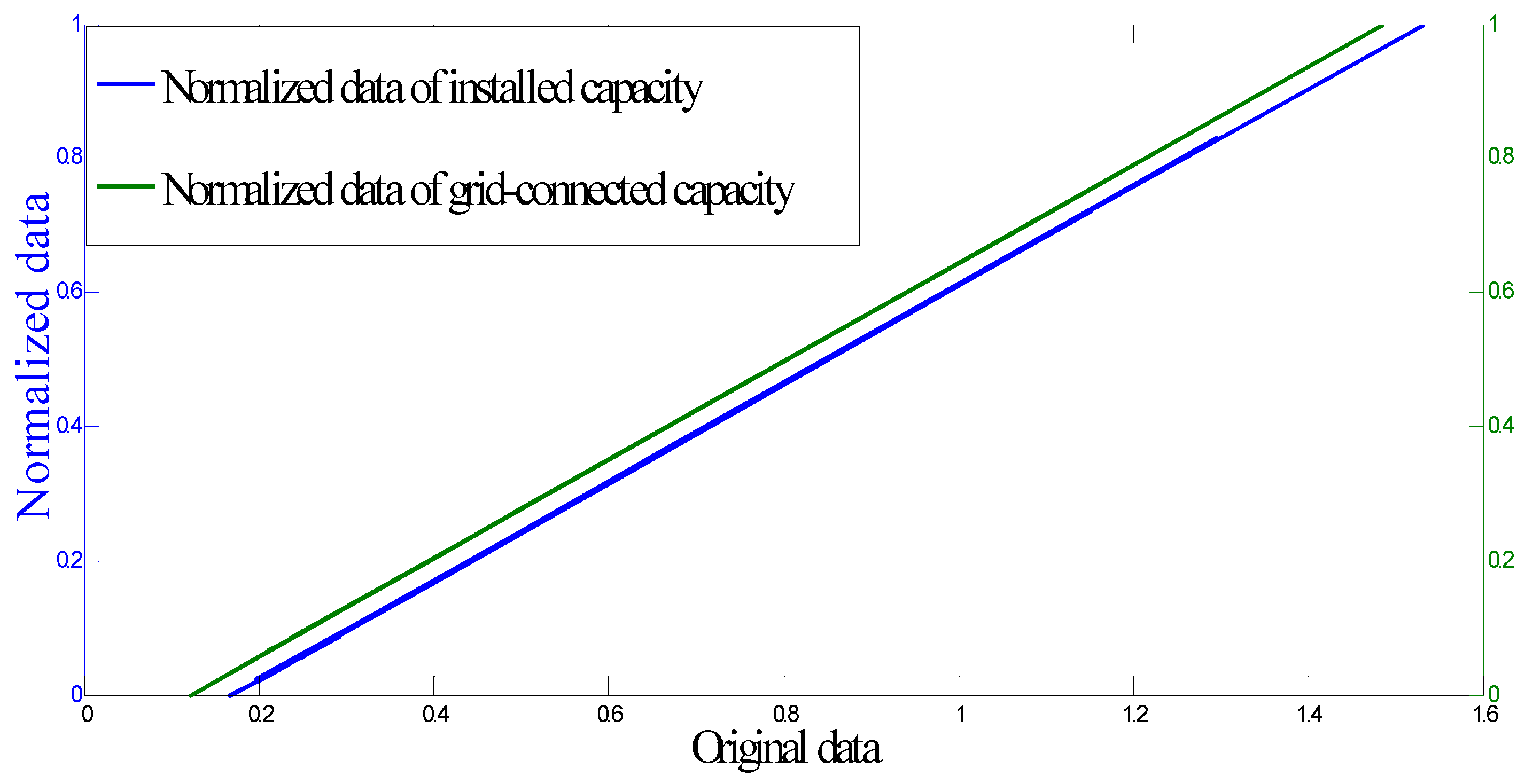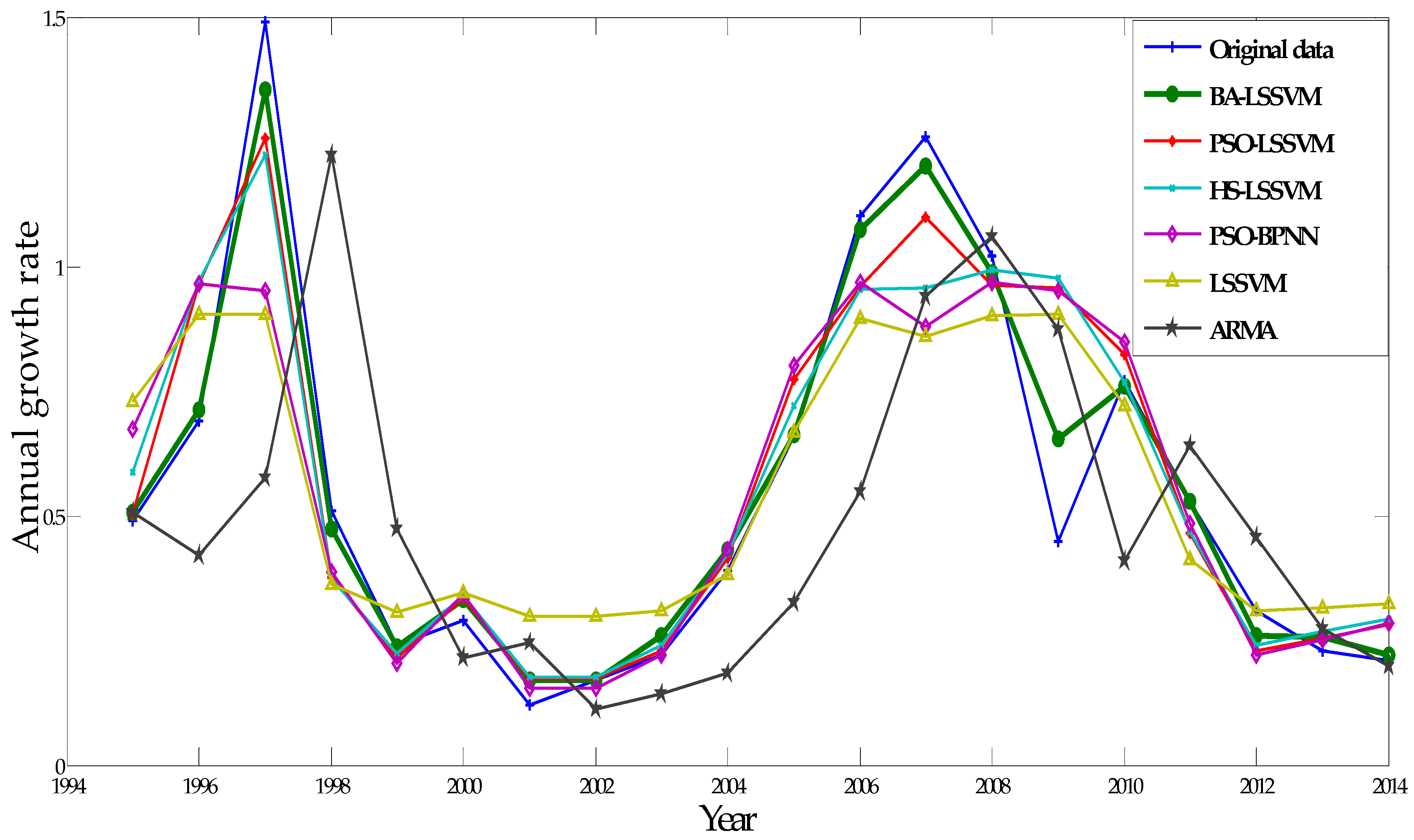1. Literature Review
As one of the most proven forms of environmentally friendly and renewable energy, wind power continues to attract considerable attention throughout the world [
1,
2,
3,
4]. In 2014, the new installed capacity of global wind power was 51,477 MW, of which China accounted for 45.4%, explicitly becoming a global leader pertaining to wind power capacity. However, this rapid integration of wind power into the grid has resulted in many operational challenges in the distribution networks since most wind farms are directly connected to the distribution network instead of the transmission network. The benefit of rapid extension of the distribution system is incident to the operational challenges. Although they have started to create impact on the overall power system operation, until recently no support were imperatively offered to the distribution/transmission system operation [
5]. For instance, the overwhelming scale and speed of deployment are now embarrassing China’s wind power industry due to grid connectivity issues. The problem of “abandoned wind” in China has led to more than 100 billion kWh of power being wasted. The disconnection between the rapid increase of wind power supply and grid-connected consumption hinders the sustainable development of the wind power industry. As the literature on grid-connected capacity prediction only gives scant regard to the disorderly expansion of wind power, there appeared to be a situation of repeated construction and “surplus production”. Therefore, the precise forecasting approaches with respect to grid-connected capacity have positive implications on the reduction of the wasted energy and the healthy and stable development of the wind power industry.
There is abundant literature on wind power predication, most of which has been published during the past few years. The predication literature covers many aspects of wind power. These include, but are not limited to, wind speed forecasting, generated power and generated energy prediction, relatively with little attention to wind power grid connected capacity prediction. The methods of these studies can be classified into two categories: time series models and artificial intelligent algorithm models. Most of these approaches utilize time series analysis, encompassing vector autoregressive (VAR) models [
6,
7] and autoregressive moving average (AMRA) models [
7,
8,
9,
10]. Torres [
8] decribed a modified ARMA model owing to the non-Gaussian nature and the non-stationary nature of wind, and the method behaved especially well in longer-term forecasting. Erdem [
9] decomposed wind speed into lateral and longitudinal components with each component being represented by an ARMA model, then the results were combined to obtain predictive values. Liu [
10] proposed an ARMA–GARCH algorithm for modeling the mean and volatility of wind speed, with the model being evaluated the effectiveness through multiple methods. The results suggested the current approach effectively grasped the trend of wind speed. Jiang [
11] presented a hybrid model of autoregressive moving average and generalized autoregressive conditional heteroscedasticity to forecast wind speed. The simulation results demonstrated the proposed method outperformed the compared approaches. Nevertheless, the extensive implementation of time series model on wind power prediction can be problematic, since it has poor nonlinear fitting performance.
Conversely, the adaptive and self-organized learning characteristics of intelligent algorithms apparently validate the estimation of nonlinear time series. For instance, artificial neural network (ANN) [
12,
13,
14,
15,
16,
17] and LSSVM [
17,
18,
19,
20] are perceived to be highly effective methods in the field of wind power forecasting. Guo [
18] successfully conducted a hybrid Seasonal Auto-Regression Integrated Moving Average and Least Square Support Vector Machine (SARIMA-LSSVM) model to predict the mean monthly wind speed. De Giorgi [
19] developed a comparative study for the prediction of the power production of a wind farm, using historical data and numerical weather predictions. It was illustrated that the hybrid approach based on WD-LSSVM significantly outperformed hybrid artificial neural network (ANN)-based methods. Yuan [
20] established a LSSVM model with the light of gravitational search algorithm (GSA) for short-term output power prediction of a wind farm. Compared with the back propagation (BP) neural network and support vector machine (SVM) model, the modeling results indicated that the GSA–LSSVM model had higher accuracy for short-term output power prediction. Wang [
21] decomposed the non-stationary time series into several intrinsic mode functions (IMF) and the trend item, then each IMF was forecasted by diverse LSSVM models. These forecasting results of each IMF were combined to gain the final value of output power of the wind farm.
With the rapid development of artificial intelligence technology, many scholars are devoting growing time and resources to delve deeper into LSSVM. Since the regularization parameter
c and the kernel parameter σ of the LSSVM have a great influence on the performance of the prediction model, a body of studies established LSSVM model based on different intelligent algorithms for wind power prediction achieving better overall results [
21,
22,
23,
24]. Hu [
22] constructed a corrected quantum particle swarm optimization (QPSO) algorithm for LSSVM parameters selection, and as a result, the generalization capability and learning performance of LSSVM model was clearly enhanced. Sun [
23] introduced a LSSVM model optimized by PSO. The simulation results recognized that the proposed method can distinctly increase the predicting accuracy. Wang [
24] designed a LSSVM model, the parameters of which were tuned by a particle swarm optimization based on simulated annealing (PSOSA). Four wind farms as a case study in Gansu Province, Northwest China were applied to corroborate the effectiveness of the hybrid model. Song [
25] employed a novel hybrid prediction model using harmony search (HS) and LSSVM. In the pilot study, HS addressed the issue of the blindness of parameter selection and kernel function of LSSVM, realizing the adaptive selections of regularization parameter
c and kernel function parameter σ. Compared with the BP neural network and traditional statistical regression model, the HS–LSSVM model had higher precision and forecasting efficiency.
However, it is clear that from the previous research that PSO results in a local optimum during the regularization parameter selection process. In addition the weak local search ability of the HS algorithm has negative implications on the convergence rate. In order to implement the shortcomings of existing algorithms, in 2010, a new global algorithm, namely, the bat algorithm (BA), was developed by Yang, based on the echolocation behavior of bats [
26]. With a good combination of the paramount advantages of PSO, genetic algorithm (GA) and HS, the superiority of BA relies on its simplification, powerful searching ability and fast convergence. Recently, a burgeoning number of studies are focusing on BA for parameter optimization [
26,
27,
28,
29,
30]. Hafezi [
27] exploited a compound BA strategy to predict stock prices over a long term period. The model was tested for forecasting eight years of DAX stock prices in quarterly periods and was perceived as a suitable tool for predicting stock prices. Meng [
28] applied a novel bat algorithm (NBA) to four real-world engineering designs, and the effectiveness, efficiency and stability of NBA in the light of biological basis were noticeably promoted. Senthilkumar [
29] selected the best set of features from the initial sets through BA conceived as one of the recent optimization algorithm for reducing the time consumption in detecting record duplication. Venkateswara Rao [
30] adopted BA to minimize real power losses in a power system for generation reallocation with unified power flow controller. Yang [
31] explored a new multi-objective optimization approach on the basis of BA to suppress critical harmonics and foster power factor for passive power filters (PPFs). Considering the excellent performance of BA in the process of parameter optimization, it is the purpose of the present paper to utilize BA to select the two pertinent parameters of the LSSVM model and gain the global optimal solution.
Furthermore, a wealth of variables have an impact on the forecasting accuracy and efficiency, and there has been less research looking at the input selection. These studies tend to select inputs using personal experience alone. However, in this paper, not only Stationarity, Cointegration and Granger causality tests are conducted to select the environmental factor reasonably [
32], but also the partial autocorrelation analysis (PACF) is presented to calculate the lags of the growth rates of grid-connected capacity. Then, this study performed a BA-LSSVM hybrid model for wind power grid connected capacity prediction.
The principal purpose of this study is to investigate the accurate forecasting method of wind power capacity. In this research, a hybrid model which based on BA-LSSVM is applied. The parameters in LSSVM are fine-tuned by BA to ensure the generalization and the learning ability of LSSVM. To select the appropriate inputs, Stationarity, Cointegration and Granger causality tests and the partial autocorrelation analysis are conducted. The proposed method is simple and effective for prediction. The focus of the study is on comparing the results obtained by the BA-LSSVM, PSO-LSSVM, HS-LSSVM, PSO-BPNN, single LSSVM and ARMA models. This paper is divided into five major sections as follows.
Section 2 describes the principles of BA and LSSVM respectively. In
Section 3 a hybrid model is constructed which is designed to predict grid connected capacity in relation to wind power. Then, the proposed model is examined by a case study and a deep comparison of the existing methods. Finally,
Section 5 provides some conclusions of the whole research.
3. Bat Algorithm-Least Squares Support Vector Machine (BA-LSSVM) Approach
Based on BA-LSSVM model, the basic steps of parameter optimization can be described as follows:
(1) Parameters setting
The main parameters of BA are initial population size n, maximum iteration number N, original loudness A, pulse rate r, location vector x, speed vector v.
(2) Initialization population
Initialize the bat populations position, each bat location strategy is a component of
c and σ, which can be defined as follows:
where the dimension of the bat population:
d = 2.
(3) Update parameters
Calculate the fitness of population, find the current optimal solution and update the pulse frequency, speed and position of bats as follows:
where
β denotes uniformly random numbers, β ∈ [0,1];
fi is the search pulse frequency of the bat
i,
fi ∈ [
fmin,fmax];
and
are the speeds of the bat
i at time
t and
t–1, respectively; further,
and
represent the location of the bat
i at time
t and
t–1, respectively;
x* is the present optimal solution for all bats.
(4) Update loudness and pulse frequency
Produce uniformly random number
rand, if
rand >
ri, disturb the optimal strategy randomly and acquire a new strategy; if
rand <
Ai and
f(
x) >
f(
x*), then the new strategy can be accepted as well as the
ri and
Ai of the bat are updated as follows:
where
α and
γ are constants.
(5) Output the global optimal solution
The current optimal solution can be obtained depending on the sort of all fitness values of the bat population. Repeat steps Equation (2) to Equation (4) till the maximum iterations and output the global optimal solution. Thus, a wind power grid connected capacity prediction model is performed.
In sum, the BA-LSSVM algorithm flow chart is demonstrated in
Figure 2. Firstly, LSSVM approach is employed to model the training set, and the mean square error of true value and predictive value is adopted as a fitness function of BA. Then, the group of parameter of LSSVM is optimized by BA for the minimum fitness value. Finally, the LSSVM model with optimal parameters can be applied to predict the wind power grid connected capacity.
Figure 2.
The flow chart of BA-LSSVM.
Figure 2.
The flow chart of BA-LSSVM.
5. Conclusions
In order to forecast the grid-connected capacity of wind power efficiently, a hybrid model is framed in this study. Firstly, Stationarity, Cointegration, Granger causality tests and PACF are employed to select the input of LSSVM method. Then, the regularization parameter c and kernel parameter σ of the proposed models are optimized by BA. Finally, the presented method with favorable learning ability and generalization is applied to predict the growth rate of grid-connected capacity of wind power.
According to the different prediction algorithms and the three evaluation indexes, the following conclusions may be drawn: (a) the hybrid LSSVM models and the pure LSSVM model outperform ARMA; (b) the different criteria of the BA-LSSVM are minimum in comparison with PSO-LSSVM and HS-LSSVM; (c) The improved LSSVM approaches have higher forecasting accuracy than PSO-BPNN. The exciting results demonstrate that the accuracy improvement of the BA-LSSVM can reach about 20%, which indicates the current method is a very promising algorithm for wind power grid connected capacity prediction.
Regarding some limitations of this study, further research is necessary. First, this study only selected installed capacity as an exogenous variable of the growth rate of grid-connected capacity, thus the other relevant factors that affect the grid-connected capacity are needed to investigate in further research.
Second, in this paper a normalized method were adopted to reduce the prediction error of LSSVM. To enhance forecasting accuracy further, future studies need to explore more effective approach of data processing.


